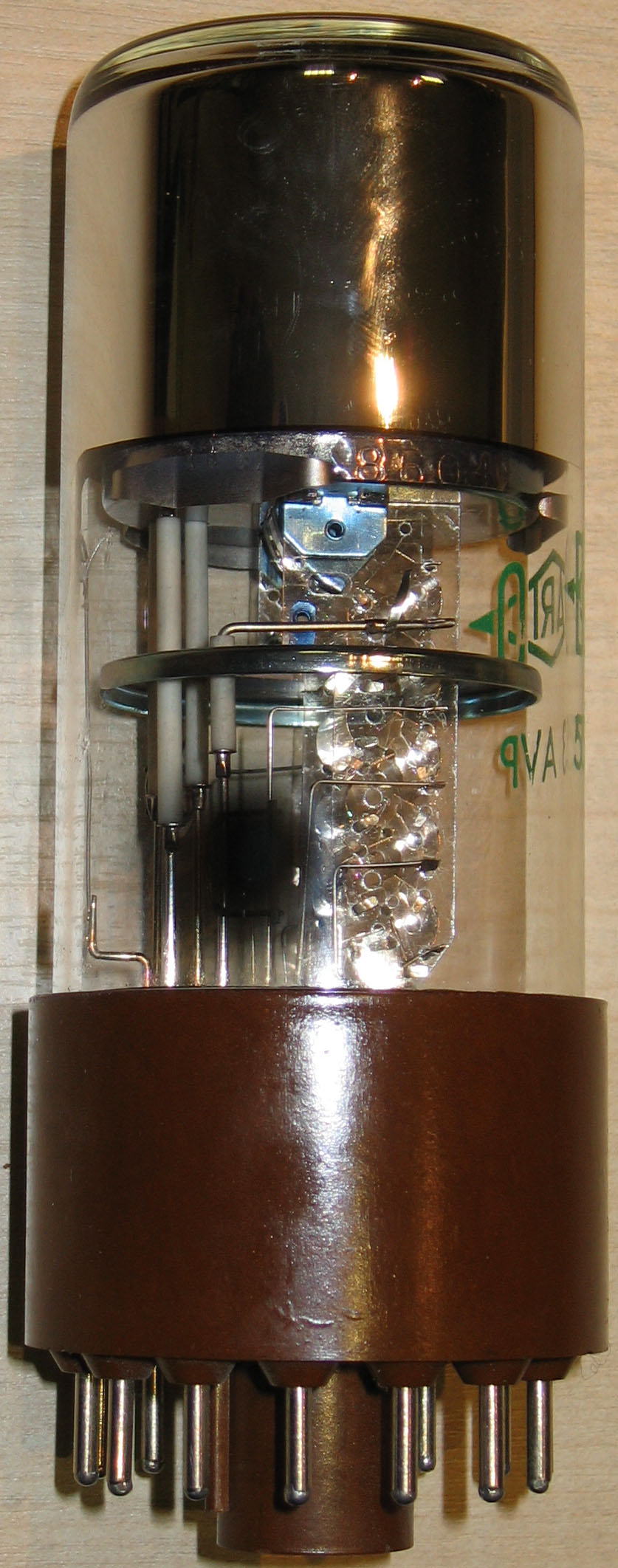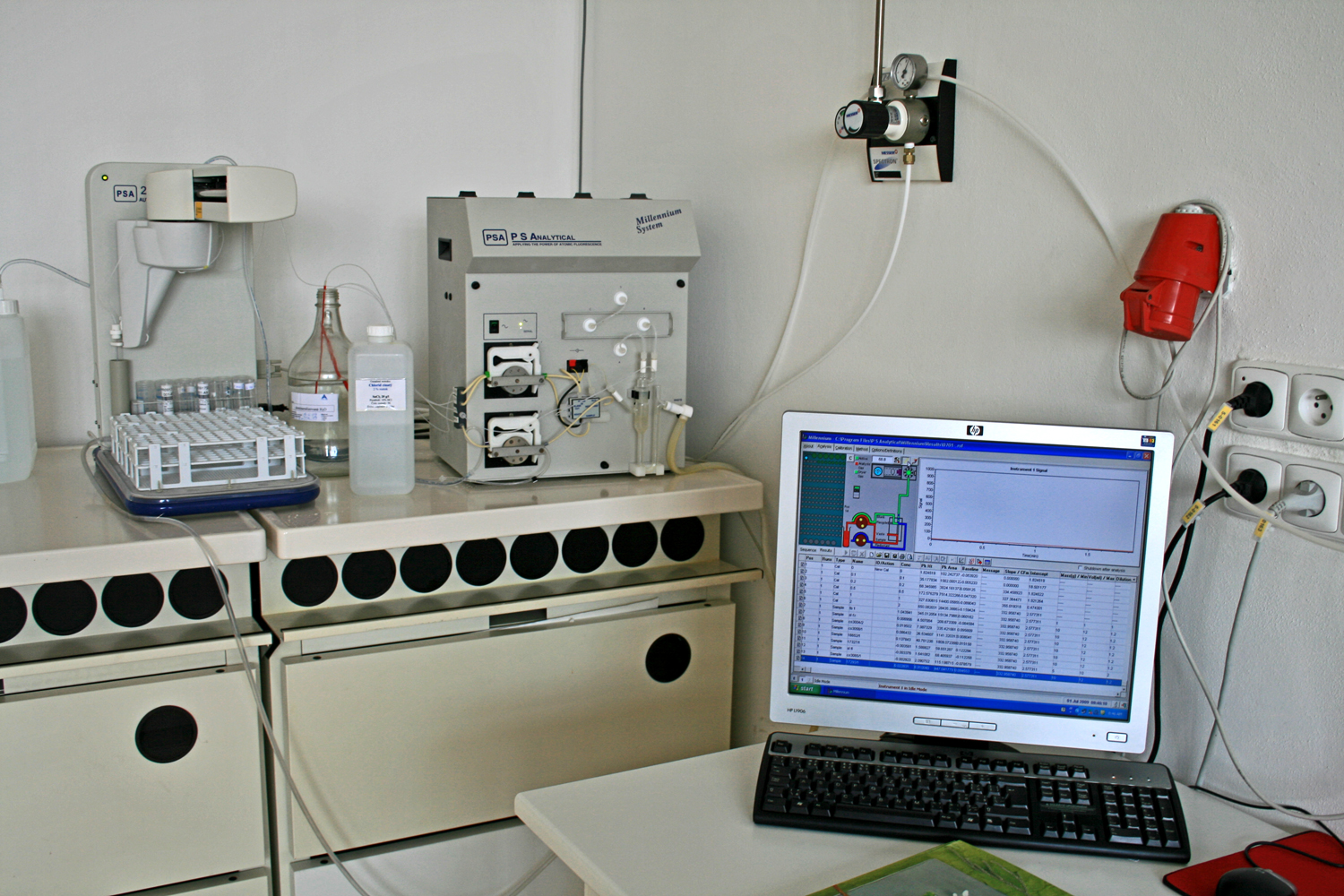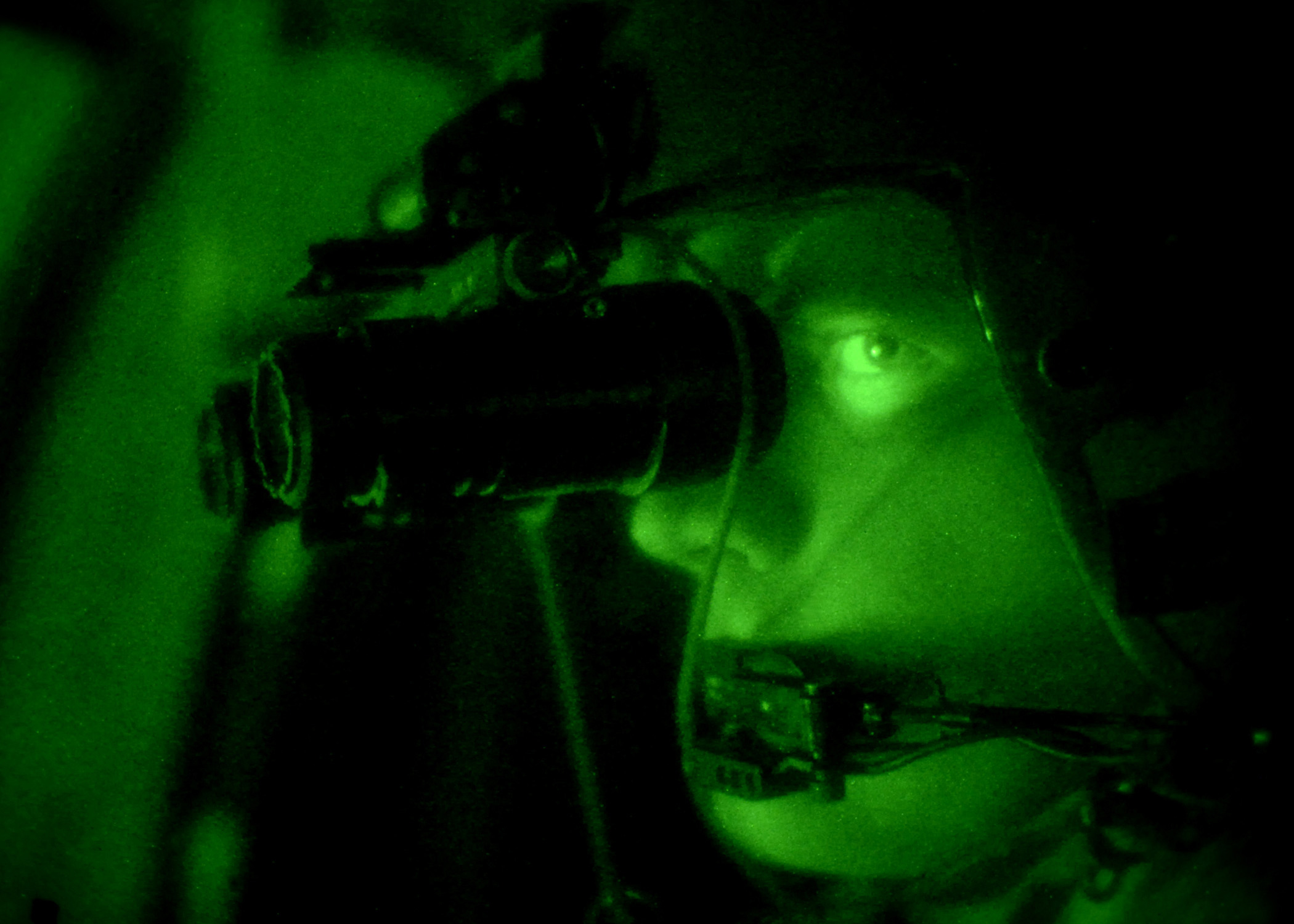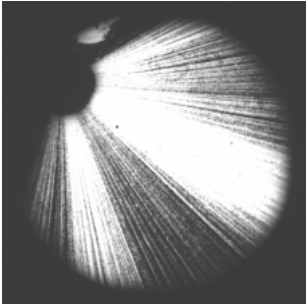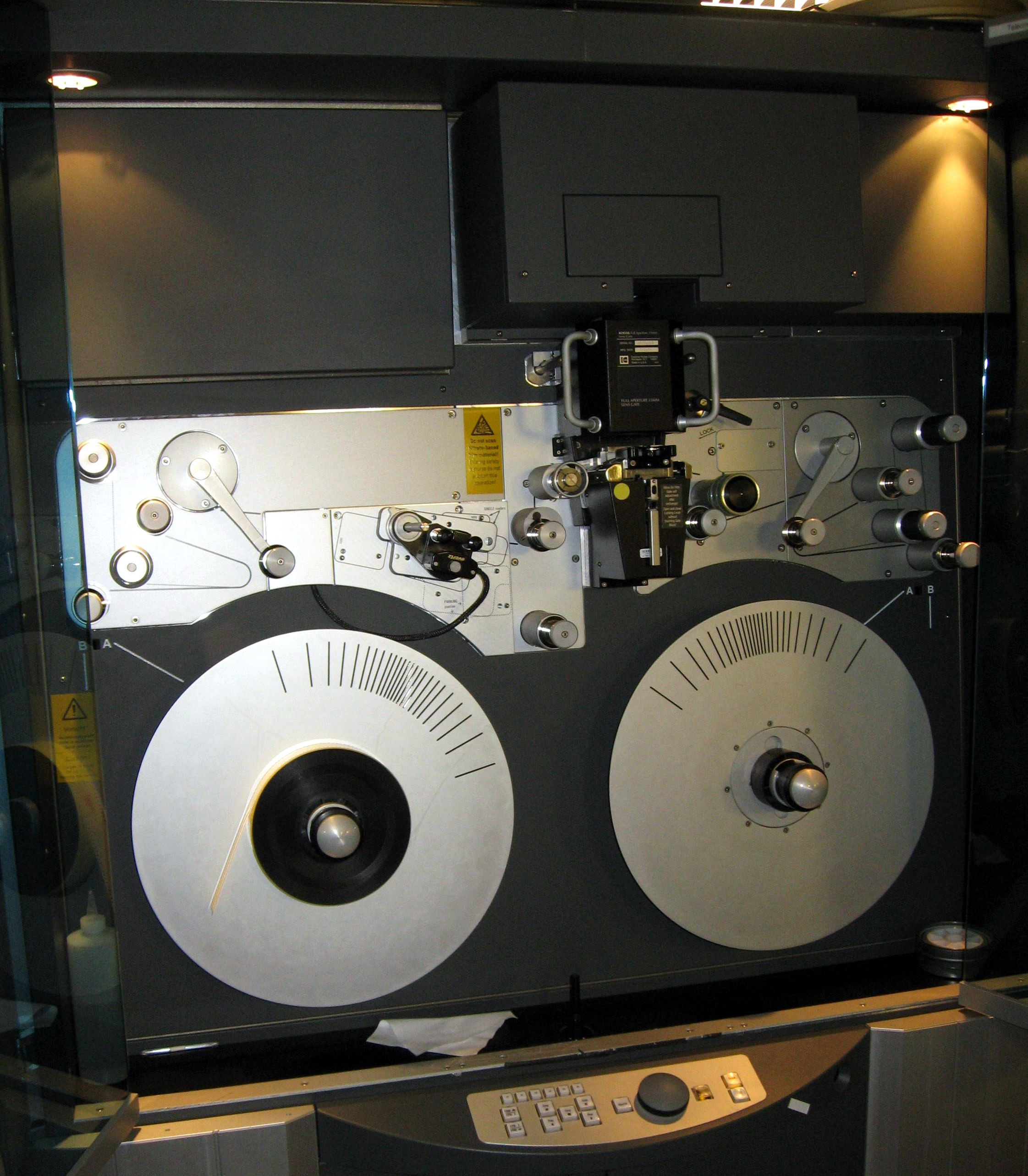|
Photomultiplier Tube
Photomultiplier tubes (photomultipliers or PMTs for short) are extremely sensitive detectors of light in the ultraviolet, visible, and near-infrared ranges of the electromagnetic spectrum. They are members of the class of vacuum tubes, more specifically vacuum phototubes. These detectors multiply the current produced by incident light by as much as 100 million times or 108 (i.e., 160 dB),Decibels are power ratios. Power is proportional to I2 (current squared). Thus a current gain of 108 produces a power gain of 1016, or 160 dB in multiple dynode stages, enabling (for example) individual photons to be detected when the incident flux of light is low. The combination of high gain, low noise, high frequency response or, equivalently, ultra-fast response, and large area of collection has maintained photomultipliers an essential place in low light level spectroscopy, confocal microscopy, Raman spectroscopy, fluorescence spectroscopy, nuclear and particle physics, astronomy, medical ... [...More Info...] [...Related Items...] OR: [Wikipedia] [Google] [Baidu] |
Fluorescence Spectroscopy
Fluorescence spectroscopy (also known as fluorimetry or spectrofluorometry) is a type of electromagnetic spectroscopy that analyzes fluorescence from a sample. It involves using a beam of light, usually ultraviolet light, that excites the electrons in molecules of certain compounds and causes them to emit light; typically, but not necessarily, visible light. A complementary technique is absorption spectroscopy. In the special case of single molecule fluorescence spectroscopy, intensity fluctuations from the emitted light are measured from either single fluorophores, or pairs of fluorophores. Devices that measure fluorescence are called fluorometers. Theory Molecules have various states referred to as energy levels. Fluorescence spectroscopy is primarily concerned with electronic and vibrational states. Generally, the species being examined has a ground electronic state (a low energy state) of interest, and an excited electronic state of higher energy. Within each of these elec ... [...More Info...] [...Related Items...] OR: [Wikipedia] [Google] [Baidu] |
Semiconductor Device
A semiconductor device is an electronic component that relies on the electronic properties of a semiconductor material (primarily silicon, germanium, and gallium arsenide, as well as organic semiconductors) for its function. Its conductivity lies between conductors and insulators. Semiconductor devices have replaced vacuum tubes in most applications. They conduct electric current in the solid state, rather than as free electrons across a vacuum (typically liberated by thermionic emission) or as free electrons and ions through an ionized gas. Semiconductor devices are manufactured both as single discrete devices and as integrated circuit (IC) chips, which consist of two or more devices—which can number from the hundreds to the billions—manufactured and interconnected on a single semiconductor wafer (also called a substrate). Semiconductor materials are useful because their behavior can be easily manipulated by the deliberate addition of impurities, known as doping. Semi ... [...More Info...] [...Related Items...] OR: [Wikipedia] [Google] [Baidu] |
Polymers
A polymer (; Greek '' poly-'', "many" + ''-mer'', "part") is a substance or material consisting of very large molecules called macromolecules, composed of many repeating subunits. Due to their broad spectrum of properties, both synthetic and natural polymers play essential and ubiquitous roles in everyday life. Polymers range from familiar synthetic plastics such as polystyrene to natural biopolymers such as DNA and proteins that are fundamental to biological structure and function. Polymers, both natural and synthetic, are created via polymerization of many small molecules, known as monomers. Their consequently large molecular mass, relative to small molecule compounds, produces unique physical properties including toughness, high elasticity, viscoelasticity, and a tendency to form amorphous and semicrystalline structures rather than crystals. The term "polymer" derives from the Greek word πολύς (''polus'', meaning "many, much") and μέρος (''meros'', meani ... [...More Info...] [...Related Items...] OR: [Wikipedia] [Google] [Baidu] |
Light Scattering
Scattering is a term used in physics to describe a wide range of physical processes where moving particles or radiation of some form, such as light or sound, are forced to deviate from a straight trajectory by localized non-uniformities (including particles and radiation) in the medium through which they pass. In conventional use, this also includes deviation of reflected radiation from the angle predicted by the law of reflection. Reflections of radiation that undergo scattering are often called ''diffuse reflections'' and unscattered reflections are called ''specular'' (mirror-like) reflections. Originally, the term was confined to light scattering (going back at least as far as Isaac Newton in the 17th century). As more "ray"-like phenomena were discovered, the idea of scattering was extended to them, so that William Herschel could refer to the scattering of "heat rays" (not then recognized as electromagnetic in nature) in 1800. John Tyndall, a pioneer in light scattering resear ... [...More Info...] [...Related Items...] OR: [Wikipedia] [Google] [Baidu] |
Night Vision Device
A night-vision device (NVD), also known as a night optical/observation device (NOD), night-vision goggle (NVG), is an optoelectronic device that allows visualization of images in low levels of light, improving the user's night vision. The device enhances ambient visible light and converts near-infrared light into visible light which can be seen by the user; this is known as I2 ( image intensification). By comparison, viewing of infrared thermal radiation is referred to as thermal imaging and operates in a different section of the infrared spectrum. A night vision device usually consists of an image intensifier tube, a protective housing, and may have some type of mounting system. Many NVDs also include a protective sacrificial lens, mounted over the front lens (ie. objective lens) on NVDs to protect the latter from damage by environmental hazards and some can incorporate [...More Info...] [...Related Items...] OR: [Wikipedia] [Google] [Baidu] |
Drum Scanner
An image scanner—often abbreviated to just scanner—is a device that optically scans images, printed text, handwriting or an object and converts it to a digital image. Commonly used in offices are variations of the desktop ''flatbed scanner'' where the document is placed on a glass window for scanning. ''Hand-held scanners'', where the device is moved by hand, have evolved from text scanning "wands" to 3D scanners used for industrial design, reverse engineering, test and measurement, orthotics, gaming and other applications. Mechanically driven scanners that move the document are typically used for large-format documents, where a flatbed design would be impractical. Modern scanners typically use a charge-coupled device (CCD) or a contact image sensor (CIS) as the image sensor, whereas ''drum scanners'', developed earlier and still used for the highest possible image quality, use a photomultiplier tube (PMT) as the image sensor. A ''rotary scanner,'' used for high-speed docume ... [...More Info...] [...Related Items...] OR: [Wikipedia] [Google] [Baidu] |
Barrage Jamming
Barrage jamming is an electronic warfare technique that attempts to blind ("jam") radar systems by filling the display with noise, rendering the broadcaster's ''blip'' invisible on the display, and often those in the nearby area as well. "Barrage" refers to systems that send signals in many bands of frequencies compared to the bandwidth of any single radar. This allows the jammer to jam multiple radars at once, and reduces or eliminates the need for adjustments to respond to any single radar. Early radar systems typically operated on a single frequency, and could only change that frequency by changing internal electronics. Against these radars, it was possible to use conventional radio sets to send out signals on the same band, causing the radar display to be filled with noise whenever the antenna was pointed in the general direction of the jammer. However, given that each individual radar would be operating on different frequencies, this " spot jamming" technique required multipl ... [...More Info...] [...Related Items...] OR: [Wikipedia] [Google] [Baidu] |
Telecine
Telecine ( or ) is the process of transferring film into video and is performed in a color suite. The term is also used to refer to the equipment used in the post-production process. Telecine enables a motion picture, captured originally on film stock, to be viewed with standard video equipment, such as television sets, video cassette recorders (VCR), DVD, Blu-ray Disc or computers. Initially, this allowed television broadcasters to produce programs using film, usually 16mm stock, but transmit them in the same format, and quality, as other forms of television production. Furthermore, telecine allows film producers, television producers and film distributors working in the film industry to release their productions on video and allows producers to use video production equipment to complete their filmmaking projects. Within the film industry, it is also referred to as a TK, because TC is already used to designate timecode. Motion picture film scanners are similar to telecines. ... [...More Info...] [...Related Items...] OR: [Wikipedia] [Google] [Baidu] |
Medical Imaging
Medical imaging is the technique and process of imaging the interior of a body for clinical analysis and medical intervention, as well as visual representation of the function of some organs or tissues (physiology). Medical imaging seeks to reveal internal structures hidden by the skin and bones, as well as to diagnose and treat disease. Medical imaging also establishes a database of normal anatomy and physiology to make it possible to identify abnormalities. Although imaging of removed organs and tissues can be performed for medical reasons, such procedures are usually considered part of pathology instead of medical imaging. Measurement and recording techniques that are not primarily designed to produce images, such as electroencephalography (EEG), magnetoencephalography (MEG), electrocardiography (ECG), and others, represent other technologies that produce data susceptible to representation as a parameter graph versus time or maps that contain data about the measurement loca ... [...More Info...] [...Related Items...] OR: [Wikipedia] [Google] [Baidu] |
Blood Tests
A blood test is a laboratory analysis performed on a blood sample that is usually extracted from a vein in the arm using a hypodermic needle, or via fingerprick. Multiple tests for specific blood components, such as a glucose test or a cholesterol test, are often grouped together into one test panel called a blood panel or blood work. Blood tests are often used in health care to determine physiological and biochemical states, such as disease, mineral content, pharmaceutical drug effectiveness, and organ function. Typical clinical blood panels include a basic metabolic panel or a complete blood count. Blood tests are also used in drug tests to detect drug abuse. Extraction A venipuncture is useful as it is a minimally invasive way to obtain cells and extracellular fluid (plasma) from the body for analysis. Blood flows throughout the body, acting as a medium that provides oxygen and nutrients to tissues and carries waste products back to the excretory systems for disposal. Conseq ... [...More Info...] [...Related Items...] OR: [Wikipedia] [Google] [Baidu] |
Diagnostics
Diagnosis is the identification of the nature and cause of a certain phenomenon. Diagnosis is used in many different disciplines, with variations in the use of logic, analytics, and experience, to determine "cause and effect". In systems engineering and computer science, it is typically used to determine the causes of symptoms, mitigations, and solutions. Computer science and networking * Bayesian networks * Complex event processing * Diagnosis (artificial intelligence) * Event correlation * Fault management * Fault tree analysis * Grey problem * RPR Problem Diagnosis * Remote diagnostics * Root cause analysis * Troubleshooting * Unified Diagnostic Services Mathematics and logic * Bayesian probability * Block Hackam's dictum * Occam's razor * Regression diagnostics * Sutton's law copy right remover block Medicine * Medical diagnosis * Molecular diagnostics Methods * CDR Computerized Assessment System * Computer-assisted diagnosis * Differential diagnosis * Medical dia ... [...More Info...] [...Related Items...] OR: [Wikipedia] [Google] [Baidu] |
